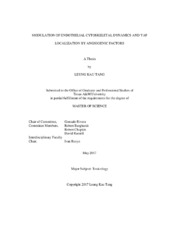| dc.description.abstract | Angiogenesis, the formation of new blood vessels from pre-existing ones, plays a crucial role in physiological processes and various pathological conditions including cancer. Angiogenic factor stimulation, including hepatocyte growth factor (HGF) and vascular endothelial growth factor (VEGF), promote endothelial cell cytoskeletal remodeling and sprouting angiogenesis. Gab1 and Nck are interacting scaffold proteins that integrate and specify cues from angiogenic factors that impact cytoskeletal dynamics. Recent findings indicate that the activity of Yes-associated protein (YAP), a transcriptional co-activator and effector of growth control and tumor suppressor in the Hippo pathway, is modulated by cytoskeletal remodeling during angiogenesis. The existing literature suggests that the architecture of the cytoskeleton, including the organization of actin filaments (F-actin) and vascular endothelial cadherin (VE-cadherin) cell adhesions modulate the activity of YAP. Therefore, the Gab1/Nck complex is uniquely positioned to coordinate cytoskeletal changes during sprouting angiogenesis that potentially alter the activation of YAP. Here, we determined the role of Gab1 and Nck in specifying the subcellular distribution and activation of endothelial YAP in response to angiogenic factor stimulation. We hypothesized that Gab1- and Nck-dependent cytoskeletal changes, i.e. stress fiber formation and cell-cell adhesion remodeling, play a significant role in the nuclear translocation and regulation of the phosphorylation state of YAP. Our results show that both HGF and VEGF stimulation induce the formation of a signaling complex that includes Gab1 and Nck. Disruption of this complex through silencing approaches disrupts the localization of VE-cadherin junctions and facilitates the formation of endothelial gaps in confluent endothelial monolayers. In sparsely seeded endothelial cells, disruption resulted in altered actin dynamics; loss of Nck, but not Gab1, induced the nuclear translocation of YAP when endothelial cells were exposed to angiogenic factor stimulation. These results suggest that the Gab1/Nck complex contributes to regulation of the structural and functional integrity of the endothelium and the angiogenic response through mechanisms that involve modulation of YAP activation/subcellular localization. | en |


